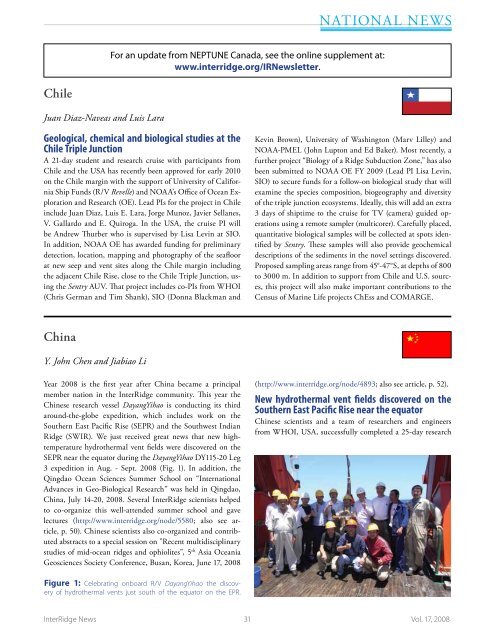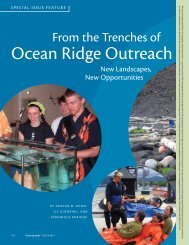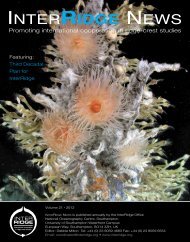Full version, lower resolution, 3.25MB - InterRidge
Full version, lower resolution, 3.25MB - InterRidge
Full version, lower resolution, 3.25MB - InterRidge
Create successful ePaper yourself
Turn your PDF publications into a flip-book with our unique Google optimized e-Paper software.
National News<br />
For an update from NEPTUNE Canada, see the online supplement at:<br />
www.interridge.org/IRNewsletter.<br />
Chile<br />
Juan Diaz-Naveas and Luis Lara<br />
Geological, chemical and biological studies at the<br />
Chile Triple Junction<br />
A 21-day student and research cruise with participants from<br />
Chile and the USA has recently been approved for early 2010<br />
on the Chile margin with the support of University of California<br />
Ship Funds (R/V Revelle) and NOAA’s Office of Ocean Exploration<br />
and Research (OE). Lead PIs for the project in Chile<br />
include Juan Diaz, Luis E. Lara, Jorge Munoz, Javier Sellanes,<br />
V. Gallardo and E. Quiroga. In the USA, the cruise PI will<br />
be Andrew Thurber who is supervised by Lisa Levin at SIO.<br />
In addition, NOAA OE has awarded funding for preliminary<br />
detection, location, mapping and photography of the seafloor<br />
at new seep and vent sites along the Chile margin including<br />
the adjacent Chile Rise, close to the Chile Triple Junction, using<br />
the Sentry AUV. That project includes co-PIs from WHOI<br />
(Chris German and Tim Shank), SIO (Donna Blackman and<br />
Kevin Brown), University of Washington (Marv Lilley) and<br />
NOAA-PMEL (John Lupton and Ed Baker). Most recently, a<br />
further project “Biology of a Ridge Subduction Zone,” has also<br />
been submitted to NOAA OE FY 2009 (Lead PI Lisa Levin,<br />
SIO) to secure funds for a follow-on biological study that will<br />
examine the species composition, biogeography and diversity<br />
of the triple junction ecosystems. Ideally, this will add an extra<br />
3 days of shiptime to the cruise for TV (camera) guided operations<br />
using a remote sampler (multicorer). Carefully placed,<br />
quantitative biological samples will be collected at spots identified<br />
by Sentry. These samples will also provide geochemical<br />
descriptions of the sediments in the novel settings discovered.<br />
Proposed sampling areas range from 45°-47°S, at depths of 800<br />
to 3000 m. In addition to support from Chile and U.S. sources,<br />
this project will also make important contributions to the<br />
Census of Marine Life projects ChEss and COMARGE.<br />
China<br />
Y. John Chen and Jiabiao Li<br />
Year 2008 is the first year after China became a principal<br />
member nation in the <strong>InterRidge</strong> community. This year the<br />
Chinese research vessel DayangYihao is conducting its third<br />
around-the-globe expedition, which includes work on the<br />
Southern East Pacific Rise (SEPR) and the Southwest Indian<br />
Ridge (SWIR). We just received great news that new hightemperature<br />
hydrothermal vent fields were discovered on the<br />
SEPR near the equator during the DayangYihao DY115-20 Leg<br />
3 expedition in Aug. - Sept. 2008 (Fig. 1). In addition, the<br />
Qingdao Ocean Sciences Summer School on “International<br />
Advances in Geo-Biological Research” was held in Qingdao,<br />
China, July 14-20, 2008. Several <strong>InterRidge</strong> scientists helped<br />
to co-organize this well-attended summer school and gave<br />
lectures (http://www.interridge.org/node/5580; also see article,<br />
p. 50). Chinese scientists also co-organized and contributed<br />
abstracts to a special session on "Recent multidisciplinary<br />
studies of mid-ocean ridges and ophiolites”, 5 th Asia Oceania<br />
Geosciences Society Conference, Busan, Korea, June 17, 2008<br />
(http://www.interridge.org/node/4893; also see article, p. 52).<br />
New hydrothermal vent fields discovered on the<br />
Southern East Pacific Rise near the equator<br />
Chinese scientists and a team of researchers and engineers<br />
from WHOI, USA, successfully completed a 25-day research<br />
Figure 1: Celebrating onboard R/V DayangYihao the discovery<br />
of hydrothermal vents just south of the equator on the EPR.<br />
<strong>InterRidge</strong> News 31 Vol. 17, 2008
















